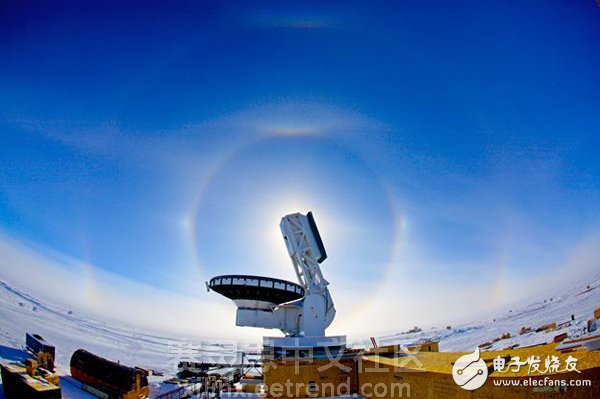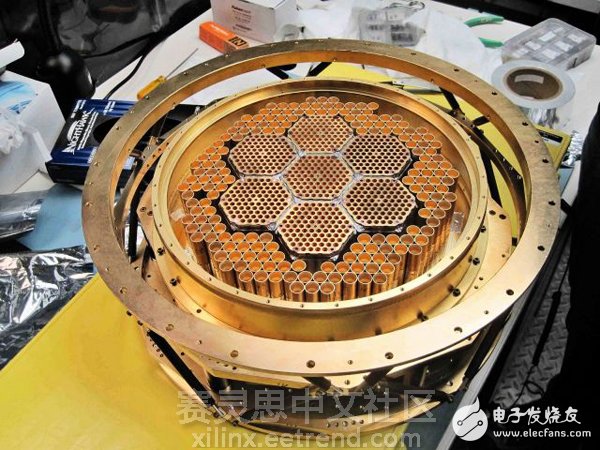An Antarctic multidisciplinary team of scientists recently glimpsed the aftermath of the Big Bang. On March 17th the team announced that the BICEP2 test found the first evidence of gravitational waves in the B-mode polarization of cosmic microwave background radiation (CMB).
Scientists are currently looking for another imprint: gravitational wave evidence recorded in the CMB microwave photon weakly polarized helix. Finding these spirals is expected to confirm the inflation view of the Big Bang theory – it believes that it expanded at a much faster rate than the speed of light before the universe was born 1 picosecond. In theory, this superluminal speed (faster than the speed of light) of the universe will produce gravitational waves, which will be branded in the polarization of the photons produced by the big bang.
The team searched for a dedicated camera on which the gravitational wave relied on using a transitional boundary sensor (TES) bolometer to measure E-mode (no spin) and B-mode (no gradient) microwave radiation. The camera was developed around McGill's second-generation DFMUX development board based on the Xilinx Virtex®-4 FPGA.
Other astrophysicists used the same Xilinx development board in their own experiments, while other researchers were experimenting with the latest upgraded cameras based on Kintex®-7 devices. The Kintex version is also part of a large telescope that Canadian scientists will use to investigate dark energy.
Resound of the big bangThe change in polarization in the CMB microwave photon is called the B-mode signal, which is extremely weak. The overall CMB blackbody temperature is 2.73K, while the B-mode signal is roughly one-tenth of a million.
The gravitational lens effect of the much larger intensity of the original "E-mode" polarized signal produces a B-mode signal at a small angular scale, while the CMB interacts with the gravitational wave background radiation generated during the inflation process to produce a B-mode signal at a large angular scale.
The SPT polarimeter (SBTpol) camera mounted on an international scientific team operating a 10-meter Antarctic Telescope (SPT) first detected the B-mode polarization caused by the CMB gravitational lens effect in 2013 (Fig. 1). SPT and BICEP2 (which will soon be upgraded to BICEP3) and the Keck array CMB test instrument are located at the Amundsen-Scott South Pole station.
The CMB is the last reverberation left with the huge energy explosion of the big bang. In 1964, Arnold Penzias and Robert Wilson accidentally discovered the source of radio noise using a cryogenic receiver at the Bell Telephone Laboratory in Holmdel, New Jersey. CMB is a source of noise that two scientists cannot eliminate from their experimental data. The discovery of CMB radiation proved the Big Bang theory, which enabled Penzias and Wilson to win the 1978 Nobel Prize in Physics.
According to the resolution of the test instruments in the early 1960s, CMB is always isotropic, day or night. This feature provides support for the theory that CMB is the afterlife of the Big Bang. More sensitive measurements (mainly measurements made by Cosmic Background Detector (COBE) satellites) map the entire sky's CMB to ultra-high resolution and then show a small change in CMB (anisotropic), which further Strengthened the theory that CMB is the big bang mark. The discovery earned George Smoot and John Mather the 2006 Nobel Prize in Physics.
æ°¦Cooled polarization sensorThe thermoelectric balance of superconductors and their ability to measure incident electromagnetic energy were discovered in the 1940s, but TES detectors were not widely used until the 1990s. They are currently widely used in CMB test instruments. The SPTpol camera's helium-cooled superconducting focal plane microwave sensor is an array of 1536 antenna-coupled TES bolometers paired with 768 polarization-sensing pixels; 180 pixels are sensitive to 90 GHz microwave radiation, while 588 pixels are paired at 150 GHz. Radiation sensitive.
The 150 GHz CMB sensor module consists of a corrugated horn antenna coupled TES bolometer manufactured by the National Institute of Standards and Technology (NIST) in Boulder, Colorado. Each 150 GHz TES bolometer module contains a detector array and 84 dual polarized pixels operating at hundreds of mK temperatures. The incident microwave energy is transmitted along the coplanar waveguide to the microstrip transition device, which feeds a lossy gold meander (a heating resistor). The incident microwave energy entering the bending resistance acts as a heating. The bending resistance is connected to a TES sensor made of aluminum-manganese alloy. These TES devices operate in the middle of their superconducting phase transitions and are therefore extremely sensitive to small changes in received light intensity.
The 90GHz CMB sensor consists of a separately packaged dual polarization polarimeter developed by Argonne National Laboratory. Each 90 GHz pixel is connected to the telescope by a machined contoured feedhorn that transmits CMB radiation to a resistive PdAu absorber. The resistive absorber is heated and connected to the molybdenum/gold double layer TES (see Figure 2).

Figure 1 – Antarctic Telescope at the Amundsen-Scott South Pole Station

Figure 2 – Microwave focal plane array of the Antarctic telescope. The inner seven hexagonal modules are 150 GHz arrays and the outer ring is a 90 GHz array. Each pixel has its own independent horn antenna that couples light to each of the two similar TES bolometers.
The æ°¦-cooled superconducting focal plane microwave sensor of the Antarctic telescope camera is an array of 1536 antenna-coupled TES bolometers paired into 768 polarization-sensing pixels.
For 150 GHz and 90 GHz sensors, thermal changes due to microwave energy absorption cause a slight change in the resistance of each TES at several Hz levels. The change in resistance can regulate the carrier current flowing through each of the 1536 TES bolometers. These currents are then amplified by a low temperature superconducting quantum interferometer (SQUID). Transferring 1536 measurements from the ultra-low temperature environment of the focal plane sensor and SQUID array to the relatively warm environment of the South Pole requires the development of an innovative digital frequency division multiplexing (DFMUX) solution using Xilinx Virtex-4 FPGA.
SQUID has high bandwidth, so the frequency division multiplexing scheme can be easily utilized in this application. This multiplexing scheme allows for the sharing of SQUIDs and minimizes the number of wires in the cryostat responsible for cooling the focal plane sensor array without reducing the noise performance of the individual bolometers. DFMUX was developed by McGill University in Montreal and is one of the agencies responsible for operating the Antarctic telescope. Other institutions include the University of Chicago, the University of California at Berkeley, Case Western Reserve University, the Harvard/Smithsonian Astrophysics Observatory, the University of Colorado at Boulder, the University of California at Davis, and Ludwig-Mark, Munich, Germany. West Milian University, Argonne National Laboratory and the National Institute of Standards and Technology (NIST).
Understanding sensor dataThe SPTpol camera features the second generation McGill DFMUX based on the Xilinx Virtex-4 FPGA. The FPGA is capable of digitally synthesizing a carrier comb consisting of 12 carrier frequencies using a direct digital synthesis (DDS) method. The carrier comb enters the focal plane cryostat through a single line and drives a set of (12) TES bolometers. A separate analog LC filter can fine tune each of these 12 TES bolometers into a narrow band. Each bolometer responds to time-varying incident CMB radiation, and its resistance fluctuates in the frequency range of 0.1 Hz to 20 Hz. The different resistances of the TES bolometer can regulate the carrier current flowing through it. The 12 TES bolometer currents are then added together to form a modulated "sky signal."
Another DDS frequency comb drive called the "Zero" comb drives the summing node at the input of the SQUID amplifier. The phase and amplitude of the zeroing comb are set to cancel the carrier comb by means of destructive interference, leaving only the signal detected by the bolometer and a small amount of residual carrier power. A SQUID is responsible for amplifying this signal, converting it to a voltage, and then sending it back to the room temperature electronics for filtering, analog-to-digital conversion, and demodulation by the FPGA. Figure 3 is a system block diagram.

Figure 3 – Block diagram of a DFMUX-based TES bolometer system for measuring CMB radiation.
The digital output of the ADC goes directly to the Virtex-4 FPGA for demodulation. The demodulation scheme is similar to the digital upconversion/downconversion (DUC/DDC) algorithm for GSM mobile phones, with some exceptions. First, the bandwidth of each TES bolometer channel is very narrow – only a few tens of Hz levels. Second, the carrier comb consists of a comprehensive sinusoidal carrier generated by a Virtex-4 FPGA. Carrier modulation is performed within a TES bolometer in a cryostat.
A Virtex-4 FPGA can handle four of a set of (12) bolometer multiplexers for an SPTpol camera. The DFMUX design uses Virtex-4 FPGA's on-chip logic, memory and DSP functions for digital frequency synthesis, demodulation (downconversion, filtering and decimation), time stamping and buffering. Since an FPGA is used to simultaneously generate the carrier frequency comb and zero frequency comb and demodulate the sky signal, all signals are synchronized. Comb generation and demodulation are unlikely to shift from each other because they come from the same master clock in the FPGA. Therefore, clock jitter is not a serious source of noise and can be proved by measurement.
Fully functional FPGATwo main modules are implemented in the FPGA: Digital Multi-Frequency Synthesizer (DMFS) and Digital Multi-Frequency Demodulator (DMFD). The system design uses two identical DMFS modules for frequency synthesis. One module generates a carrier frequency comb and the other generates a zero adjustment signal. The frequency synthesizer operates at 20MHz with a 16-bit DAC running at 25Msps. The synthesizer is based on an 11-bit 2's complement direct digital synthesizer created with the Xilinx DDS compiler. The frequency resolution per channel is 0.006 Hz.
The demodulation of the sky signal begins with digital down conversion. The received signal is mixed with the reference waveform to produce a separate baseband signal. The frequency and phase of the reference waveform are independent of each other. The modulated sky signal has been sampled at 14-bit resolution at a sampling rate of 25 Msps, but the target bandwidth is much lower than the Nyquist bandwidth of this sampling rate. Therefore, the modulated baseband signal flows through a cascaded integrator comb (CIC) decimation filter composed of an adder and an accumulator in the FPGA. The first stage CIC filter extracts the baseband signal with a precision of 28 bits and a factor of 128. The output of this filter is then truncated to 17 bits.
The DFMUX time domain multiplexes 8 bolometer channels (25Msps) to CIC1 running at 200MHz. The CIC1 filter has a 28-bit data width and a 24-bit output. After CIC1 filtering is completed, all bolometer channels are multiplexed together and fed a single CIC2 with six variable decimation rates (16, 32, 64, 128, 256, and 512). CIC2 is followed by a 152-tap FIR filter.
The channel identifier and time stamp are added to the output of the FIR filter and then sent to a dual port buffer with a list of polling buffers. The large buffer capacity of the SDRAM facilitates the latency requirements of the FPGA-based Micro- BlazeTM soft processor, which runs Linux and is responsible for monitoring the data flow in the system. The reduced latency allows the MMU to be activated and significantly improved Linux OS operation.
The DFMUX development board can be externally controlled using two web servers running on the MicroBlaze processor and connecting to the Ethernet via the HTTP interface. Controlling the DFMUX development board requires only a web browser. The Python scripting environment provides direct access to board-level control registers for more detailed tasks such as instrument fine-tuning.
Future work for DFMUXThe SPTpol camera is one of several experimental instruments for exploring CMB radiation. The same DFMUX development board used in the camera is also part of the EBEX balloon carrying the "E and B test instrument" and the polar bear CMB polarization test instrument installed at the Chilean Ike Observatory Huan Tran telescope. A new version of the DFMUX development board based on the Xilinx Kintex-7 FPGA, called ICEboard, has been deployed to the new CMB test set and the Canadian Hydrogen Intensity Mapping Experiment (CHIME) radio telescope.
CHIME is a new radio telescope in a remote valley near Penticton, British Columbia. The telescope consists of five large 100 ï‚´ 20 m semi-cylinder reflectors (size and shape comparable to a half-tube slide) with a radio receiver array mounted at the focal point of each half cylinder. There are no moving parts (except the Earth) here. Upon completion, CHIME will be able to measure more than half of the sky every day as the Earth turns.
However, CHIME is not used to study CMB. It aims to find evidence of dark energy – by investigating 21 centimeters (400 to 800 MHz) of radio radiation in a large 3D sky in the range of 7-11 billion light years away. CHIME will measure "Byton Acoustic Oscillation" (BAO), which is a periodic density change in a large celestial body composed of hydrogen. BAO material accumulation can provide astronomers with a "standard gauge" of approximately 490 million light years, which can be used to measure a wide range of distances. BAO signal fluctuations may prove to be signs of dark energy, at least there is a silver lining.
CHIME is actually a phased array radio telescope. It can synthesize images by recording the electromagnetic signals of a fixed antenna array and then reconstructing the sky from the relevant data using 2D correlation and interferometry. CHIME needs to process BAO signal data received at speeds of several Tbps using 160 interconnected Kintex-7 FPGAs.
Superluminal speedThe theory of cosmic inflation suggests that the universe experienced a dramatic expansion after 10-35 seconds of the Big Bang – physical expansion beyond the speed of light. If you think that the speed of light is the speed limit – and most of us think so, it is difficult to accept this view. Part of the Big Bang theory believes that inflation in addition to CMB leaves a cosmic gravitational wave background radiation (CGB), and CGB is labeled with a polarized mark in the CMB. The BECEP2 test results confirmed this theory for the first time.
Other results from the SPTpol camera, EBEX, Polar Bear, Keck array and BICEP3 trials are expected to reinforce these findings. For its part, CHIME will further expand our knowledge of the universe after starting the dark energy search.
Spiral Rotor Flowmeter,marine helical rotor flowmeter,lzx type marine helical rotor flowmeter
Taizhou Jiabo Instrument Technology Co., Ltd. , https://www.taizhoujbcbyq.com